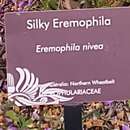pt-BR
nomes no trilho de navegação


Eremophila nivea, commonly known as silky eremophila, is a flowering plant in the figwort family, Scrophulariaceae and is endemic to Western Australia. In nature it is a rare shrub with hairy branches and leaves, and blue, purple or violet flowers.
Eremophila nivea is an erect shrub which grows to a height of between 0.8–1.6 m (3–5 ft). Its branches, leaves and sepals are covered with a layer of soft white to greyish matted hairs giving the plant a silvery-greyish appearance. The leaves are arranged alternately along the branches and are linear in shape, mostly 8–18 mm (0.3–0.7 in) long, 1.5–2.5 mm (0.06–0.1 in) wide and have a covering of woolly hairs.[2][3]
The flowers are borne singly or in pairs in leaf axils on woolly stalks 2–5.5 mm (0.08–0.2 in) long. There are 5 overlapping, triangular to lance-shaped, tapering sepals which are 14–21 mm (0.6–0.8 in) long and have purplish-black tips. The petals are 15–23 mm (0.6–0.9 in) long and are joined at their lower end to form a tube. The petal tube is lilac-coloured, white with yellow-brown spots inside. The outer surface of the tube and both surfaces of the lobes are glabrous but the inside of the tube is filled with long, soft hairs. The 4 stamens are fully enclosed in the petal tube. Flowering occurs from August to October and the fruits which follow are dry, woody, oval-shaped with a pointed end and 4.5–6 mm (0.18–0.24 in) long.[2][3]
The first formal description of this species was published in 1986 by botanist Robert Chinnock and the description was published in Nuytsia.[4] The specific epithet (nivea) is a Latin word meaning "snowy" or "snow-white"[5] in reference to the colour of the hairs on the branches and leaves of this species.[2]
Eremophila nivea is only known in the wild from near Three Springs in the Avon Wheatbelt and Yalgoo biogeographic regions.[6] Only a few populations are known, some of which are in danger of roadworks as they occur on road verges.[2] It grows in sandy clay and clay-loam.[3]
This species is classified as "Threatened Flora (Declared Rare Flora — Extant)" by the Department of Environment and Conservation (Western Australia)[6] and an Interim Recovery Plan has been prepared.[7]
Although rare in nature, silky eremophila is often available in specialist nurseries with its popularity in part due to its soft, silvery-grey foliage and pale to deep blue flowers. A form with white flowers is also sometimes available. It can be propagated from cuttings or by grafting onto Myoporum rootstock and opinion amongst horticulturalists differ on which is the better method. It will grow in most soils, is both drought and frost tolerant but needs to be grown in full sun. It benefits from regular pruning after flowering to preserve its shape and to help prevent fungal diseases.[8]
 Habit
Habit Eremophila nivea, commonly known as silky eremophila, is a flowering plant in the figwort family, Scrophulariaceae and is endemic to Western Australia. In nature it is a rare shrub with hairy branches and leaves, and blue, purple or violet flowers.
Eremophila nivea est une espèce de plantes originaire d'Australie, classiquement placée dans la famille des Myoporaceae et regroupée dans la famille des Scrophulariaceae.
Elle mesure 1 mètre à 2,5 mètres de hauteur. Ses feuilles persistantes sont pubescentes, gris-blanc. Elle donne des fleurs mauve d’août à octobre en Australie ; de la fin de l'hiver au début de printemps, voire de mars à juillet dans d'autres parties du monde en fonction du climat.
La première description de l'espèce a été publiée par Robert Chinnock en 1986 dans la revu australienne Nuytsia. L'épithète spécifique du nom botanique ( nivea ) vient du latin qui signifie « neige » ou « blanc comme neige » en référence à la couleur des poils sur les branches et les feuilles de cette espèce.
Cette espèce n'est connue à l'état naturel que près de Three Springs (Australie-Occidentale) dans le Avon Wheatbelt et la région biogéographique de Yalgoo (voir IBRA). Seules quelques populations sont connues, dont certaines sont en danger en raison de travaux routiers. Elle pousse sur des terrains argilo-sableux et argilo-limoneux.
Eremophila nivea est une espèce de plantes originaire d'Australie, classiquement placée dans la famille des Myoporaceae et regroupée dans la famille des Scrophulariaceae.
Eremophila nivea là một loài thực vật có hoa trong họ Huyền sâm. Loài này được Chinnock mô tả khoa học đầu tiên năm 1986.[1]
Eremophila nivea là một loài thực vật có hoa trong họ Huyền sâm. Loài này được Chinnock mô tả khoa học đầu tiên năm 1986.